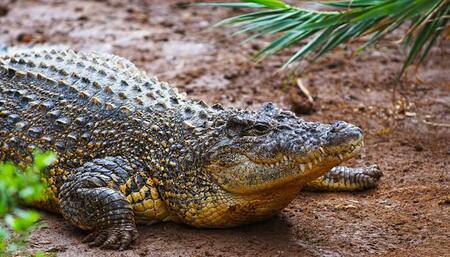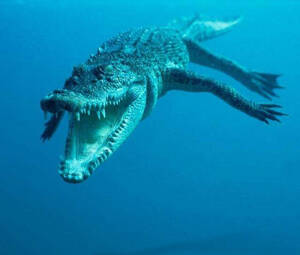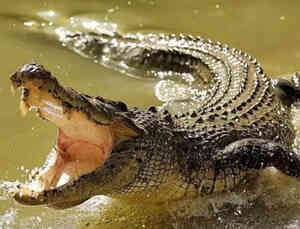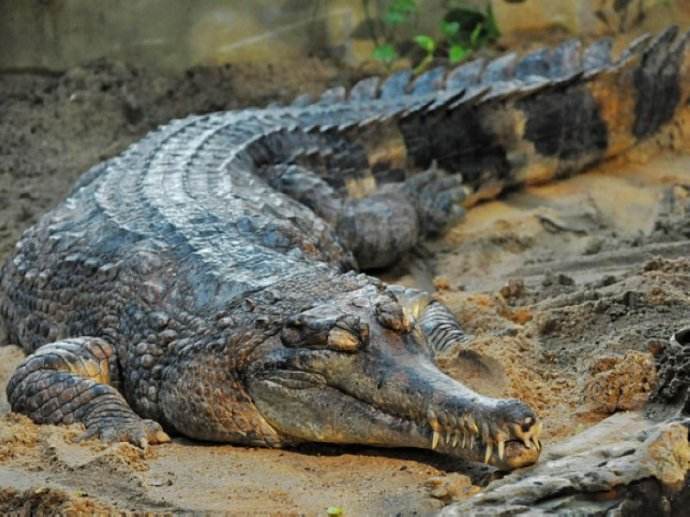Crocodilia
IUCN
LCBasic Information
Scientific classification
- name:Crocodilia
- Scientific Name:
- Outline:Crocodilia
- Family:Crocodilia Crocodylomorpha Archosauromorpha
Vital signs
- length:1.2-7m
- Weight:Up to 1 ton or more
- lifetime:70 to 80 years old
Feature
Body structure: Crocodiles have a body structure that is well adapted to both aquatic and terrestrial life. They have a long, flat body that helps them swim quickly in the water, while their strong tails help them keep their balance in the water. Crocodiles have short, powerful limbs that are suitable for running and hunting prey on land. In addition, the crocodile's skin is covered with hard scales, which not only protect the body from external damage, but also reduce friction in the water.
Predatory behavior: Crocodiles are cunning predators that move slowly and steadily. They usually lurk in mud or lakes, waiting for prey to approach and suddenly attack. Crocodiles' eyes and nostrils are located on the top of their heads, allowing them to observe their surroundings and breathe underwater. Crocodiles have particularly wide mouths with multiple rows of sharp teeth, which are very suitable for hunting prey.
Adaptability: Crocodiles have amazing adaptability an
Distribution and Habitat
They live in lakes, swamps, shallows, rivers and other environments with large amounts of water, or in moist areas in hills. Except for a few that live in temperate zones, most crocodiles live in rivers, lakes and watery swamps in tropical and subtropical regions, and some live in shallows near the coast.
Appearance
Body shape: Crocodiles have long torsos, well-developed muscles, short and thick limbs, and thick and slightly flat tails.
Head: The head is flat, the skin of the head is close to the skull, the skull is firmly connected and cannot move; the eyes are small and slightly protruding; the external nostrils are located on the back of the snout, with valves on them; the tongue is short and flat and cannot extend outward.
Teeth: The teeth are conical and grow in the alveoli, with more than 25 teeth on each side.
Scales: There are armor-like scales.
Details
Crocodilia (scientific name: Crocodile, foreign name: Crocodile) is a typical large carnivore belonging to the class Sauropoda of the phylum Chordata. It is distributed in rivers, lakes, and coasts from tropical to subtropical areas. There are 25 species in existence.
Appearance characteristics
Crocodilia is a reptile of the family Crocodilia and the family Alligatoridae of the order Crocodilia, with a total of 8 genera and 23 species. Crocodiles have long trunks, ranging from 1.2 meters to 7 meters in length; some prehistoric species have sexual dimorphism, and males are generally larger than females. Although the shape of their snouts and teeth vary, all crocodile species have essentially the same body shape, with skin covered with coarse scales, a long, flat snout, and a flat, powerful tail; well-developed muscles; a flat head with skin that is tightly attached to the skull, which is firmly connected and cannot move; conical teeth that grow in alveoli, with more than 25 teeth on each side, and they are animals that can replace their teeth almost throughout their lives, replacing their teeth 50 times in their lifetime; a short, flat tongue that cannot protrude; small, slightly protruding eyes; a thick, slightly flat tail; short, thick limbs; external nostrils located on the back of the snout with valves; and armor-like scales.
The eyes, ear holes, and nostrils of crocodilians are located on the top of their heads, which allows most of their bodies to be submerged in water.[3] Crocodilians have a retina that enhances their vision in low light conditions; although vision is quite good in air, it is significantly reduced in underwater environments. The fovea of the eyes of other vertebrates is usually circular; in crocodilians, it is a horizontal bar across the middle of the retina. The nictitating membrane covers the eye when the body is fully submerged. In addition, glands on the nictitating membrane secrete a lubricating fluid that keeps the eye clean; this fluid is visible as "tears" when out of water and dries and falls off.
The ear openings are adapted to operate in both air and underwater environments, and the eardrums are protected by flaps that are opened or closed by muscles. Crocodilians have a wide range of hearing, with sensitivity comparable to that of most birds and some mammals.
Crocodilians have only one olfactory system, and the vomeronasal organ is absent in adults; this suggests that all olfactory perception is limited to the olfactory system. Behavioral and olfactory experiments have shown that crocodilians can detect both airborne and water-soluble chemicals, and use the olfactory system for hunting.
The well-developed trigeminal nerve enables them to detect vibrations in the water (such as those produced by potential prey). The tongue cannot move freely, but is held in place by a fold. The brain of crocodilians is quite small, but its ability to learn is greater than that of most reptiles. They lack the vocal cords of mammals and the syrinx of birds, but can produce sounds by vibrating three flaps of skin in the larynx]. Crocodiles seem to have lost their pineal glands, but they still secrete melatonin.
Crocodiles breathe with lungs, and their hearts are divided into four chambers. There is a bony palate on the roof of their mouths, which separates the nasal cavity from the oral cavity. Their teeth are only grown in the alveoli of the upper and lower jaws, which are similar to mammals, indicating that mammals evolved from reptiles. The two eyes of crocodiles grow on the upper end of their heads. In addition to the eyelids, they also have transparent nictitating membranes, which enable them to adapt to the environment in the water. Since the nostrils of crocodiles are located on the back of the upper end and have valves inside, when they dive into the water, the valves automatically close to prevent water from flowing into the nostrils. There is also a thin and elastic membrane in their pharynx. Once this membrane is closed, the oral cavity and respiratory tract are separated. Therefore, even if they open their mouths wide in the water, water will not enter the respiratory tract and lungs. Its long and thick tail is not only a "rudder" when swimming, but also a tool for hunting and a weapon to defend against enemies.
As one of the oldest species on Earth to date, crocodiles retain many characteristics of early dinosaur-like reptiles and are also known as "living fossils." Large crocodiles pose a certain threat to humans and will suddenly attack before humans can react. There is a proverb in the West called "crocodile tears," which means false compassion. It refers to the fact that when crocodiles swallow larger animals, they slowly shed water-like liquid from their eyes, making them look like they are shedding tears of sympathy. Among the 23 species of crocodiles, 13 are included in the "Red List of Endangered Species of the World Conservation Union." The Siamese crocodile is currently on the verge of extinction. The Yangtze alligator is a Chinese specialty crocodile and has been listed as a first-class protected animal in China.
Habitat
Crocodiles live in lakes, swamps, shoals, rivers, etc. with a lot of water or in humid areas in hills. Except for a few living in temperate zones, most crocodiles live in rivers, lakes and watery swamps in tropical and subtropical areas, and some live in shoals near the coast.
Living habits
Crocodiles are cold-blooded animals, the top predators in the food chain, and one of the most resilient animals in existence. They can go without food for up to half a year after a full meal. Adult crocodiles spend most of their time underwater, sometimes with their eyes and noses out of the water; they have keen hearing and vision; they come out of the water in the afternoon to bask in the sun; they are active at night; they have a dual respiratory system; they often live in groups; they like warm environments. Crocodiles mainly prey on vertebrates, but also eat mollusks and crustaceans.
Crocodiles often give people the illusion of being slow. Some people also describe crocodiles as not crawling forward with their bodies close to the ground when they move, but staggering, stretching their four legs, floating their bodies, and dragging their tails on the ground. In fact, this description is an illusion of crocodiles. In fact, crocodiles have extremely keen hearing and vision, and all parts of their bodies are very flexible. Crocodiles are typical ambush animals. When they find prey, they hide their body parts below the head under the water, then slowly approach the prey, bite the prey with their mouths and drag it into the water to drown it, and then have a good meal. Crocodiles use a movement called death flip to dismember their prey into small pieces so that they can swallow it, that is, they bite the prey tightly with their powerful jaws, and then rotate their bodies as much as possible, using the force of rotation to tear the meat off the prey. According to anatomical analysis, the food that crocodiles like to eat includes: wild ducks, hares, frogs, mice, fish, snails and other animals.
Nile crocodiles have the habit of living symbiotically with plover. This small bird often lives on the sandbanks of the Nile River. It is a good friend of crocodiles, often looking for small insects to eat on crocodiles, and sometimes it can enter the mouth of crocodiles to eat leeches parasitic in the mouth of crocodiles. Interestingly, sometimes the crocodile's mouth closes accidentally, and the little plover is trapped in the crocodile's mouth, but the crocodile does not swallow the bird. The little plover will gently hit its upper and lower jaws, and the crocodile will immediately open its mouth to let the bird fly out. Plover is a kind of bird with keen senses. As long as it hears a little movement, it will make a noise and wake up. Therefore, whenever the crocodile sleeps, the little plover will sometimes "stand guard" for it. Once there is a "situation", the plover will immediately make a noise, thus waking up the sleeping crocodile, so that the crocodile can immediately sink to the bottom of the water and avoid a disaster.
Distribution range
Most crocodiles are distributed in tropical areas of Africa, Asia, North and South America and Australia. Only the Chinese alligator and the American alligator live in temperate areas. Inhabit lakes, swamps, shallows and other areas.
Reproduction method
The gender of crocodile hatching is related to temperature. If the temperature is less than 30 degrees Celsius, all females are born; if the temperature is less than or equal to 30 to 34 degrees Celsius, the males and females are uncertain; if the temperature is more than 34 degrees Celsius, all males are born.
Crocodiles reproduce by laying eggs, and mate from December to March of the following year. When the female crocodiles reach an average length of 232 cm, they reach sexual maturity. The mating process takes place in the water, and the male crocodile will actively approach the female crocodile, then wrap the female crocodile with its forelimbs and mate with the female crocodile. The mating process may last for a long time, sometimes even for several hours.
After mating, the female crocodile will go ashore and dig a pit on land to lay eggs. Before laying eggs, they will go ashore to build their own "delivery room" with soft things such as leaves and hay. The nest is about 40-70 cm high, and the eggs are incubated by sunlight and heat from weeds. During the incubation period, the female crocodile will stay by the nest to protect the eggs and the newly hatched baby crocodiles. After the baby crocodiles hatch, the female crocodile will help them crawl out of the soil and guide them into the water. They start giving birth at the age of 12 and stop giving birth at around 40 years old. They lay 10-90 eggs each time, and it takes 84-90 days to hatch. Crocodiles have a lifespan of 65 years.
The bigger the body, the longer the life span. The smallest crocodile in existence is the dwarf crocodile, which has an average life span of 40-50 years. The larger crocodile, the Yangtze alligator, has an average life span of 50-60 years. The saltwater crocodile is the largest crocodile in existence and is also the "longevity king" among crocodiles today. Their adult individuals can be up to 6 meters long, weigh more than 1 ton, and have an average life span of 70 years.
So far, there are two crocodiles that have lived to be 100 years old. The first one is the Nile crocodile "Henry" born in 1900. It was captured at the age of 3 and has since lived in the Crocworld Conservation Center in Kwazulu-Natal, South Africa. It is now 123 years old, one of the longest-lived captive crocodiles. The second one is the saltwater crocodile "Fresh" born in 1870. It was also captured as a young child and later sent to the Australian Crocodile Conservation Center. It died in 2010. It lived a total of 140 years and is the longest-lived crocodile on record.
Classification
There are 23 species of crocodiles in 3 families, 8 genera, etc. in the world. Most of them are distributed in tropical and subtropical regions such as Africa, Central America, and southern Asia. Only the Yangtze alligator in China and the Mississippi alligator in North America are distributed in temperate zones. The main breeds of crocodiles farmed in China are Yangtze,
There are six species of crocodiles: the Chinese alligator, the Siamese crocodile (Thai crocodile), the Nile crocodile, the saltwater crocodile, the Mississippi crocodile and the caiman. Among them, the Yangtze alligator is endemic to China, while the others are species introduced from abroad.
| Continents | Body length | Living Area | scientific name |
| Asia | 3.5m | India | Gavial |
| Asia | 1.5-2m | China | Alligator sinensis |
| Asia | 4-6m | Southeast Asia and Northern Australia | Salt-water Crocodile |
| Asia | 5.47m | Africa, Madagascar | Nile Crocodile |
| Oceania | 2.5-3m | Tropical Northern Australia | Johnston's Crocodile |
| America | 3-3.4m | Mexico, Guatemala and Belize | Crocodylus moreletii |
| America | 3m | USA | American Crocodile |
| America | 4m | North and South America | Alligator |
| America | 5m | South America | Black Caiman |
| America | 1.5m | South America | Cuvier's Dwarf Caiman |

Yangtze alligator
The Yangtze alligator (Alligator sinensis), also known as the crocodile, is a species of crocodile endemic to China and the most endangered crocodile in the world. my country has listed it as a first-class protected animal in China [26], and hunting is strictly prohibited. The Yangtze alligator is small in size, with an adult weighing about 36 kilograms and a body length of generally 1.5 meters, rarely exceeding 2.1 meters. The Yangtze alligator has short and thick limbs, with five fingers on the front limbs without webbed fingers; and four toes on the hind limbs with webbed fingers. The tail is nearly as long as the body. The head is relatively large, flat and has a long snout. The eyes are completely black and have eyelids and membranes that can be opened and closed. The back of the body is gray-brown, the front of the abdomen is gray, and the gray and yellow color alternates from the anus to the back. The tail is flat on the sides. Newborn crocodiles are black with yellow stripes.

Siamese crocodile
The Siamese crocodile (Crocodylus siamensis), also known as the Thai crocodile, Siamese freshwater crocodile, and Singaporean small crocodile, is mainly distributed in Borneo, Indonesia, Malaysia, Thailand, and Vietnam in Southeast Asia. Siamese crocodile leather has a high reputation internationally. The Siamese crocodile is a medium-sized crocodile. When the baby crocodile is hatched, it is about 25 cm long. The adult crocodile can reach up to 4 meters long, and the common ones are 3 meters long. The snout of the Siamese crocodile is of medium length and slightly concave. There is a pair of short sharp ridges in front of the two eye sockets, and there is a distinct orbit between the two eye sockets on the forehead, and the squamous bone protrudes into a high ridge. It inhabits freshwater waters such as swamps, slow-flowing rivers and lakes in tropical and subtropical areas, as well as brackish and freshwater waters. It feeds on fish, and also eats amphibians, reptiles and small mammals. It reaches sexual maturity at around 10 years old. They breed from April to May every year, and females can lay 20 to 50 eggs at a time, with an incubation period of about 80 days.

Nile crocodile
The Nile crocodile (Crocodylus niloticus) is a large crocodile. Adults are 2 to 5.5 meters long and can weigh up to 120 kg. It is the most studied of the 23 crocodile species in the world. The body color of the Nile crocodile is olive green to brown, with black spots and mesh patterns. The Nile crocodile is very strong, with a strong tail that helps with swimming. Adults have dark horizontal stripes. The juveniles are dark yellow-brown, with obvious horizontal stripes on the body and tail. Female Nile crocodiles can lay about 50 eggs each time, which hatch out of the shell after 3 months. The newly born Nile crocodiles are about 30 cm long, and the mother crocodile gently holds them in her mouth and puts them into the water. The young crocodiles can grow to 60 cm at the age of 1 and 1 meter at the age of 2.

Mississippi alligator
The Mississippi alligator (Alligator mississippiensis), also known as the Mississippi alligator and the American alligator, is only found in the southeastern United States and the Mississippi River Basin, hence its name. The Mississippi alligator is a large alligator with a body length of up to 4.9 to 6.1 meters, but few existing individuals grow to this size. It mainly inhabits swamps, streams, rivers, and even smelly water. The Mississippi alligator can communicate with its own kind through sound and vision. In the Convention on International Trade in Endangered Species of Wild Fauna and Flora, the Mississippi alligator is listed in Appendix II.

Caiman
Caiman (Caiman crocodile) refers to several species of crocodiles found in southern and central America. They are related to alligators and belong to the Alligatoridae family. Animals of the genus Caiman have a transverse bone ridge at the front of their eyes, which is very similar to the glasses frame worn by people, so their English name is called spectacled crocodile. The maximum length of the common caiman can reach 250 cm, with common adults measuring 150 to 200 cm and newly hatched crocodiles measuring 20 to 25 cm. The snout is slightly elongated, with the tip slightly raised, and the snout length slightly greater than the width of the snout base. The back is olive green, with numerous dark spots on the head, body and tail, dark brown or black horizontal stripes on the back and tail, and the ventral surface is pure beige or light yellow. There are light spots on both sides of the jaws of newly hatched crocodiles, which disappear when the body is about 35 cm long. Caimans mainly live in fast-flowing and rocky rivers.

Saltwater crocodile
The saltwater crocodile (Crocodylus porosus), also known as the man-eating crocodile, estuarine crocodile, saltwater crocodile, and Malay crocodile, is the largest of the 23 crocodile species and the largest reptile in the world. It is native to Southeast Asia, such as Thailand and Malaysia, and has also been found in India. It is mainly distributed from the coast of Southeast Asia to northern Australia and Papua New Guinea. Because it is a crocodile without large scales on the back of the neck in the order Crocodilia, it is also called "naked neck crocodile". When an adult, the saltwater crocodile can generally reach 3 to 7 meters in length, up to 9 meters, and weigh 600 to 1400 kg. The mating season is between May and June every year, lasting for several hours, and fertilization only takes 1 to 2 minutes. The saltwater crocodile has a sense of territory and has a physiological structure that adapts to high-salinity water quality. It has a greater tolerance to seawater than ordinary crocodiles and is suitable for living in different wetlands, such as estuaries, mangroves, swamps, coastal and tidal zones.
Protection level
The Yangtze alligator, Central American alligator, South American alligator, narrow-snouted alligator, sharp-snouted alligator, intermediate crocodile, Philippine crocodile, Peten crocodile, Nile crocodile, Ganges crocodile, saltwater crocodile, diamond-spotted crocodile, Siamese crocodile, alligator, Malay crocodile, fish-eating crocodile, etc. are endangered wild animals and plants, and are internationally important protected species. They are listed in Appendix I of the Washington Convention CITES (Convention on International Trade in Endangered Species of Wild Fauna and Flora), and their international trade is prohibited. In addition, all species of the reptile order Crocodile, except those listed in Appendix I, are listed in Appendix II of CITES to regulate international trade.
Of the 23 species of crocodiles, 13 are included in the IUCN Red List of Threatened Species.
The Siamese crocodile is currently on the verge of extinction.
The Yangtze alligator is a crocodile that is unique to China and has been listed as a first-class protected animal in China.
Endangered reasons
Due to people's indiscriminate hunting and killing, the number of crocodiles is decreasing, and countries that produce crocodiles have enacted laws to protect them. The Yangtze alligator only lives in China and has become a precious and rare wild animal in the world. In 1973, the International Wildlife Protection Conference listed it as an endangered species and a banned species, and the Yangtze alligator has been listed as a first-class protected animal in China.



